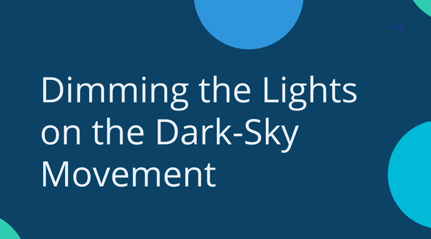
On May 5th, 2021, the Get a Grip on Lighting podcast had guest Jim Benya, an illuminating engineer and lighting designer. Benya is the creator of the BUG (backlight, uplight, glare) system as well as the Model Lighting Ordinance (MLO). The MLO is “designed to help municipalities develop outdoor lighting standards that reduce glare, light trespass and skyglow.”1
Throughout the podcast, Benya discussed multiple aspects of light pollution and the future of the Dark-Sky Movement. Benya described the 2020s as “the decade of the dark skies,”2 signaling that throughout 2020-2029, the Dark-Sky Movement will propel and flourish unlike years past.
Benya states that even with the enthusiasm he’s seen regarding the Dark-Sky Movement, there are many hurdles and obstacles that will influence the outcome of the Dark-Sky Movement.
What is Light Pollution?
Light pollution is the use of light throughout the night that can be deemed unnecessary, and is prevalent mostly in cities and surrounding areas. Light pollution can be found in “building exterior and interior lighting, advertising, commercial properties, offices, factories, streetlights, and illuminated sporting venues.”3 This form of pollution can cause disruptions to human health and psychology as well as disruptions to plant and animal physiology.
Benya stated that light pollution in the cities is seen directly through horizontal vs vertical lights. Horizontal lights cause significant light pollution as it takes a significantly longer time for these lights to break up prior to hitting the atmosphere. Vertical lights are a much better option as these lights break up faster compared to horizontal lights. While vertical lights are deemed better than horizontal lights, they are still a significant cause of light pollution. Every year, for a week around September 11th, the city of New York lights two horizontal lights representing the Twin Towers called the “Tribute in Light.” While a great remembrance, these lights affect over 160,000 birds every year. Around the same time, thousands of birds begin their migration process. These birds will circle the lights continuously exhausting themselves and unable to continue the migration process as they steered themselves off course.
As a response to this disruption to the migration process, the “Tribute of Light” has now implemented volunteers whose sole duty is to monitor these birds during this event. Once the count reaches 1,000 birds, “volunteers ask that the lights be turned off for about 20 minutes to free the birds from the seemingly magnetic hold of the lights.”4
As light pollution tends to disrupt animal habits, affect human routine, and cause an increase in energy costs, the Dark-Sky Movement has begun as a way to counteract light pollution as well as bring nature back to communities affected by light pollution.
What is the Dark-Sky Movement?
The Dark Sky Movement is a program designed to help reduce light pollution and assist in providing animals a safer environment without getting disrupted by light pollution. This movement also helps the disruptions experienced by humans, nature, and to view natural phenomena currently blocked due to light pollution.
The International Dark-Sky Association (IDA) is a non-profit created in 1988 designed to implement exactly that. The IDA hopes to do this with “four strategic priorities:
- Celebrate The Night: Increase awareness of the benefits of the night for all living things, and how light pollution is an urgent environmental threat that individuals can help solve.
- Dark Sky Protection: Protect exemplary dark skies through our certification program.
- Lighting Where We Live: Engage cities and communities in reducing light pollution through responsible lighting policy and practice.
- Skyshed Restoration: Implement coordinated, intentional, and scalable actions to slow, halt, and reverse the increasing rate of light pollution.”5
These priorities are all centered around the wellbeing of animals, human nature, energy efficiency, and night protection.
The Wastefulness of Light Pollution
One of the biggest disadvantages of light pollution is that it is deemed entirely wasteful. Light pollution occurs at night and while for safety reasons lighting is deemed a necessity, the biggest culprits of light pollution are major cities. Outside building lights are considered an unnecessary expense. For residential homes, flood lights and wall packs are considered the biggest contributors of light pollution.
Source: https://www.darksky.org/light-pollution/energy-waste/
The Dark-Sky Movement is beginning to look at lights that may be more energy efficient as well as financially a better fit. Benya stated that the DesignLights Consortium® (DLC®) is “putting together a program where they will be able to put qualified products lists for dark skies, just like they do for energy efficiency.”2
Benya states that one significant way to help the Dark-Sky Movement and prevent light pollution is to try and implement more lights that are vertical based rather than horizontal. He said if we switch “street lighting, parking lots, wall packs, [and] flood lights”2 this would lead to a significant impact and could help with “half of light pollution.”2
The IDA estimates that “30 percent of all outdoor lighting”6 is wasteful. Installing outdoor lighting that is not as wasteful, “could cut energy by 60-70 percent”6 which would result in significant savings as well as a decrease in light pollution.
Animal Disruption
Light pollution also causes a severe disruption to many animals all over the world. Depending on how much light is produced by light pollution, this causes nocturnal animals internally to alter their schedules and confuse night for day. As nocturnal animals are more active at night, without night ever coming they are unaware of when to hunt, eat, migrate, and reproduce as they believe it is still day due to the brightness brought on by light pollution.
Light pollution has caused a disruption to ocean wildlife as well. When turtles hatch at night, they tend to follow the moonlight to the ocean. With light pollution, they are confusing those lights for moonlight and instead of heading towards the ocean, baby sea turtles are leading away from the ocean towards the cities leading to more predators and obstacles as they get further away from safety in the ocean. Coral on the Great Barrier Reef also uses moonlight to grow. Light pollution can shield the moonlight which disrupts the coral’s growth.
Research has also shown that amphibians have seen a disruption from light pollution, “Artificial lights disrupt [their nighttime croaking] nocturnal activity, interfering with reproduction, which reduces populations.”7
Additional animals affected by light pollution include7
|
- Hummingbirds |
- “Little” penguins |
- Sweat bees |
|
- Monarch butterflies |
- Zooplankton |
- Songbirds |
|
- Bats |
- Mice |
- Geckos |
|
- Wallabies |
- Zebrafish |
- Seabirds |
|
- Atlantic salmon |
- European perch |
- Peahens |
|
- Owls |
- Insects |
- Fireflies |
Health Disruptions
While light pollution affects the mating of animals and hunting schedules, light pollution also affects their internal clock. Humans can also have the same side effect from light pollution. Light pollution is typically blue or white light focused, and that particular light color is extremely disruptful to human sleep patterns and schedules.
Disrupting this sleep schedule and our internal clock can lead to “several medical disorders in humans, including depression, insomnia, cardiovascular disease, and cancer.”8
Eliminating or lessening the intake of blue light throughout the evening is the most effective way to perfect our internal clocks. With less blue lights would also lead to a decrease in light pollution.
The International Dark-Sky Association has implemented Dark Sky Reserves, Parks, and Communities that feature little to no light pollution.
Dark Sky Reserves
The IDA has implemented International Dark Sky Reserves which are “public or private land[s] possessing an exceptional or distinguished quality of starry nights and nocturnal environment that is specifically protected for its scientific, natural, educational, cultural, heritage and/or public enjoyment.”9
These reserves must meet numerous guidelines related to the Dark-Sky Movement and are utilized to view the natural phenomena of nature including the Milky Way.
The current Certified IDA International Sky Reserves9 include
|
- Alpes Azur Mercantour (France) |
- Exmoor National Park (England) |
- Pic du Midi (France) |
|
- Aoraki Mackenzie (New Zealand) |
- Kerry (Ireland) |
- Rhön (Germany) |
|
- Brecon Beacons National Park (Wales) |
- Mont-Mégantic (Québec) |
- River Murray (Australia) |
|
- Central Idaho (U.S.) |
- Moore's Reserve (South Downs, England) |
- Snowdonia National Park (Wales) |
|
- Cévennes National Park (France) |
- NamibRand Nature Reserve (Namibia) |
- Westhavelland (Germany) |
|
- Cranborne Chase (England) |
- North York Moors National Park (U.K.) |
- Yorkshire Dales National Park (U.K.) |
Similar to the Reserves, there are also Dark Sky Parks all over the world.
Dark Sky Communities
Another feature of the Dark-Sky Movement are Dark Sky Communities. These communities are a “town, city, municipality or other legally organized community that has shown exceptional dedication to the preservation of the night sky through the implementation and enforcement of a quality outdoor lighting ordinance, dark sky education and citizen support of dark skies. Dark-Sky Communities excel in their efforts to promote responsible lighting and dark sky stewardship, and set good examples for surrounding communities.”10
The current Certified IDA International Dark Sky Communities10 include
|
- Beverly Shores, IN |
- Dripping Springs, TX |
- Horseshoe Bay, TX |
- Nucla and Naturita, CO |
|
- Big Park / Village of |
- Flagstaff, AZ |
- Julian, CA |
- Ridgway, CO |
|
- Bon Accord (Canada) |
- Fountain Hills, AZ |
- Ketchum, ID |
- Sark (Channel Islands) |
|
- Borrego Springs, CA |
- Fredericksburg, TX |
- Lakewood Village, TX |
- Sedona, AZ |
|
- Camp Verde, AZ |
- Fulda (Germany) |
- Moffat (Scotland) |
- Thunder Mountain |
|
- Coll (Scotland) |
- Hawthorn Woods, IL |
- Møn and Nyord (Denmark) |
- Torrey, UT |
|
- Cottonwood, AZ |
- Helper, UT |
- Niue (NU) |
- Westcliffe & Silver Cliff, CO |
|
- Crestone, CO |
- Homer Glen, IL |
- Norwood, CO |
- Wimberley Valley, TX |
While these Dark Sky Reserves and Communities bring nature back to the forefront, what is being implemented to bring the Dark-Sky Movement to major cities, the biggest culprits of light pollution?
The Future of the Dark-Sky Movement and Prevention of Light Pollution
While the IDA began in 1988 and the Dark-Sky movement in the 1950’s, the guidelines of the Dark-Sky Movement are a relatively new implementation. There have been numerous advocates of the Dark Sky Movement including the IDA, the DLC and the IES, the Illuminating Engineering Society of North America.
While there are not yet statewide regulations related to the Dark-Sky Movement, the Dark-Sky Communities and Reserves provide a safe place free of light pollution. The IDA also provides a guideline on which outdoor lighting fixtures would be most beneficial while also reducing light pollution. The IDA and IES Model Lighting Ordinance, which Benya contributed to, is also a resource for municipalities to “develop outdoor lighting standards that reduce glare, light trespass, and skyglow.”11
Benya states there are still various hurdles to get over regarding the Dark-Sky Movement. Understanding spectrum and color temperature as related to light pollution are just a few but even with those, will the 2020’s be the decade of dark skies?
Curious about light pollution in your area? Check out this interactive map: https://cires.colorado.edu/artificial-sky
Sources
1 International Dark-Sky Association
2 Get a Grip on Lighting Podcast - Starving for Darkness #6
3 International Dark-Sky Association
4 New York's 9/11 'Tribute in Light' endangers 160,000 birds annually: Study
5 International Dark-Sky Association
6 International Dark-Sky Association
7 IDA: Light Pollution Can Harm Wildlife
8 Missing the Dark: Health Effects of Light Pollution
9 International Dark-Sky Association
.png?width=500&name=2019%20e%20news%20spotlight%20logo%20(1).png)




